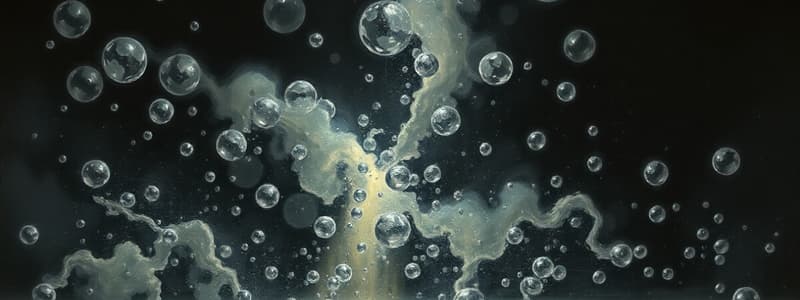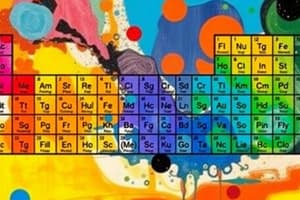Podcast
Questions and Answers
What is the primary purpose of the periodic table?
What is the primary purpose of the periodic table?
- To organize elements according to their chemical properties (correct)
- To visualize atomic structures
- To predict chemical reactions
- To categorize elements based on their atomic weight
Which subatomic particle is positively charged?
Which subatomic particle is positively charged?
- Proton (correct)
- Positron
- Electron
- Neutron
In atomic structure, where are neutrons primarily located?
In atomic structure, where are neutrons primarily located?
- Floating freely in space
- Within the atomic nucleus (correct)
- Separated from protons
- In the electron cloud surrounding the nucleus
Which of the following correctly describes the calculation of atomic mass?
Which of the following correctly describes the calculation of atomic mass?
What does the term 'matter' refer to in a scientific context?
What does the term 'matter' refer to in a scientific context?
Flashcards
Periodic Table
Periodic Table
Organized chart of elements.
Atomic Structure
Atomic Structure
Protons, neutrons, and electrons.
Matter
Matter
Anything that takes up space and has mass.
Atomic Location
Atomic Location
Signup and view all the flashcards
Calculations
Calculations
Signup and view all the flashcards
Study Notes
Matter
- Pure substances contain only one type of matter. Elements and compounds are types of pure substances.
- Mixtures contain two or more substances.
- Compounds are formed when two or more different types of atoms bond together.
- Elements are the simplest form of matter, cannot be broken down further and all atoms within an element are identical.
Periodic Table
- Elements are arranged in order of increasing atomic number (number of protons).
- Elements are categorized as metals, nonmetals, and metalloids.
- Metals generally lose electrons to form positive ions (cations).
- Nonmetals generally gain electrons to form negative ions (anions).
- Metalloids exhibit properties of both metals and nonmetals.
- Elements in the same group (column) have similar properties due to similar numbers of valence electrons.
- Elements in the same period (row) have different properties.
- Group 1 elements are alkali metals (highly reactive).
- Group 2 elements are alkaline earth metals (highly reactive).
- Group 17 are Halogens.
- Group 18 are Noble Gases (very unreactive).
Atomic Structure
- Atoms are composed of protons, neutrons, and electrons.
- Protons and neutrons are located in the nucleus.
- Protons have a positive charge.
- Neutrons have no charge.
- Electrons have a negative charge and are found outside the nucleus.
- The number of protons defines the element.
- Atomic number = number of protons.
- Atomic mass = number of protons + neutrons.
Atomic Structure and Location
- Atoms are mostly empty space.
- Electrons are found in specific energy levels or shells around the nucleus.
- Each energy level has a certain capacity for electrons.
- Electrons absorb energy to move to higher energy levels (excited state).
- Electrons emit energy to return to lower energy levels (ground state).
- Valence electrons are those in the outermost energy level.
Calculations
- All nonzero digits are significant figures.
- Zeroes between nonzero digits are significant.
- Zeroes to the right of a decimal point but before a nonzero digit are insignificant.
- Zeroes used for placeholding are not significant.
- When multiplying or dividing, the final answer has the fewest significant figures of any number in the calculation.
- When adding or subtracting, the final answer has the fewest decimal places of any number in the calculation.
- Density = mass/volume
- Percent error = [(measured value - actual value)/actual value] × 100
Studying That Suits You
Use AI to generate personalized quizzes and flashcards to suit your learning preferences.




